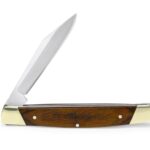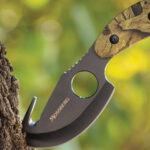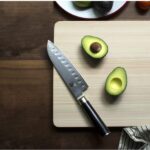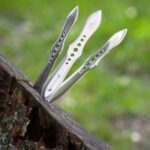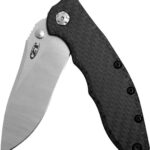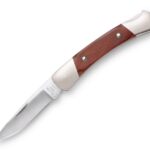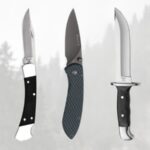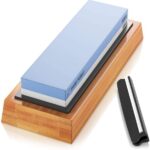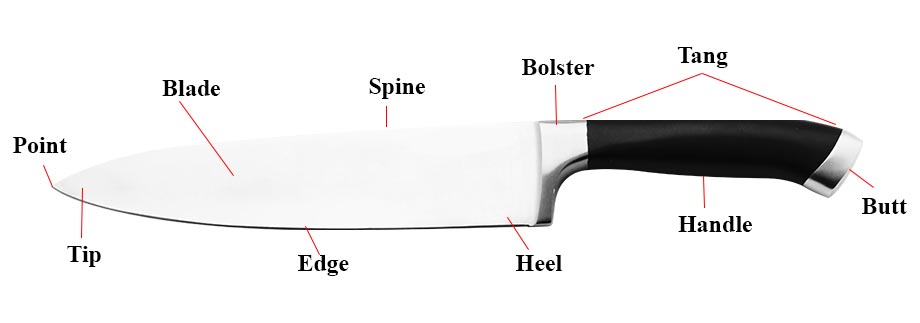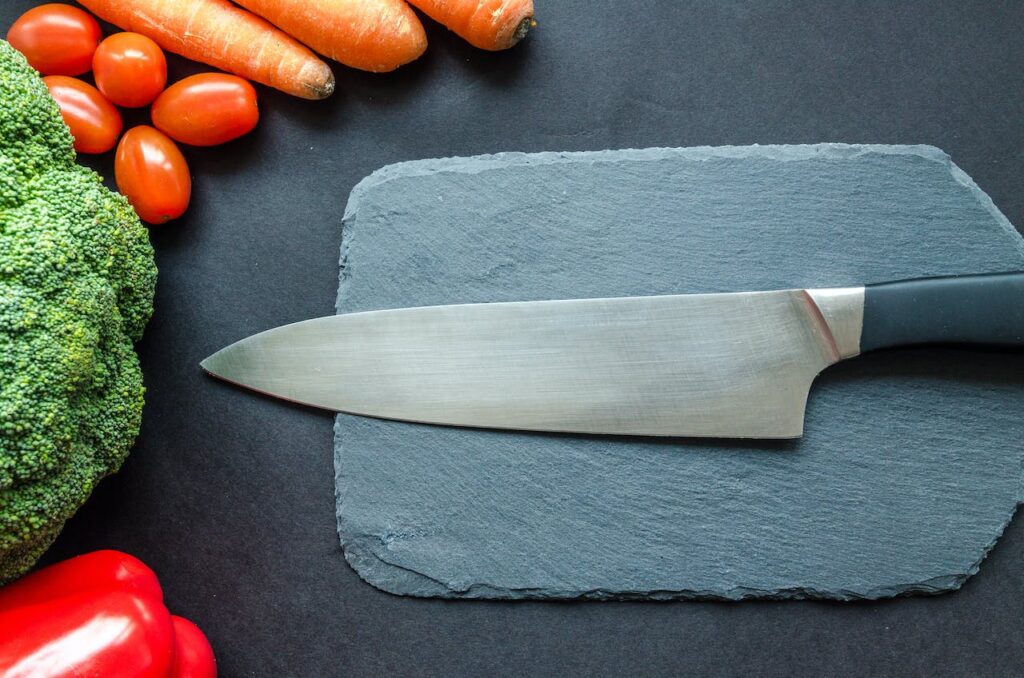
Who We Are
Here at KnivesAdvisor, our goal is to provide you with high quality product reviews, recommendations, and advice on everything related to knives. We cover all kinds of knives, from basic kitchen knives to specialized hunting knives. And everything in between.
We’ve gathered information on all the top brands, so you can feel confident you’re purchasing the correct knife for your needs.
Knives Wiki – A Comprehensive Guide
Knives have been an essential tool for survival for centuries. There is so much more to a knife than the blade and handle. Hundreds of different types exist and most have a specific purpose. This complete guide to knife anatomy goes beyond the structure and gives you a total overview of knives, the materials used to make them and their purposes.

Knife Anatomy
The two main parts of a knife are the blade and the handle, but there is much more to it than that.
The Handle
The back end of the knife is called the knife butt. The knife handle is made for comfort and a proper fit in the hand. The knife tang is the extension of the blade that goes down into the handle for stability. In better made knives, it runs through the center of the handle to the end of the butt.
The knife bolster is the raised collar part in between the handle and the blade. It adds mass to thee knife for balance, stability and strength.
The finger guard portion of the bolster is there for the safety of your fingers, to prevent accidental cuts by stopping your hand from sliding down the knife blade. It also adds extra weight for balance and knife strength.
The Blade
The blade is made up of several parts. The knife heel is the part that is on the opposite end of the point. is The knife spine or back is the full thickness part that is opposite the cutting edge.
The cutting edge, also referred to as the blade is the sharpened edge that is used for cutting. The knife tip is the pointed part that makes up the the upper one third of the blade. It is used for doing finer work in most cases.
The knife point is the sharpest point of the tip area and its main function is piercing.
Forged & Stamped Knives – How Are They Different?
A forged knife is made from a heat forging process that shapes the steel molecules of the blade. During the process, the knife bolster is made as an extension of the blade for additional strength.
A stamped knife is made from a sheet of stainless steel. It is cut by a machine that literally stamps out the blade like a cookie cutter. After stamping, the handle is added to the knife.
Stamped knives do not have a bolster. The bolster is the distinguishing feature of a forged knife. Forging makes the stainless steel materials stronger than the stamped blades, therefore, they hold their edge for longer than the stamped type. While stamped knives are less expensive to purchase, forged knives are easier to sharpen and they stay sharper for longer.

Main Ingredients of Steel
The main ingredients used in steel are carbon, chromium, cobalt, copper, manganese, molybdenum, nickel, nitrogen, phosphorus, silicon, sulfur, Tungsten and vanadium.
Each of these compounds adds to the virtue of the steel in some way. Chromium and copper help stainless steel to resist corrosion, Molybdenum make the steel stronger at high temperatures and other steel strengtheners are cobalt, nickel, phosphorus and silicon.
Carbon is the essential in ingredient in steel as a hardening agent. Sometimes Nitrogen is substituted for carbon for the same purpose. Vanadium and Tungsten increase wear resistance, while manganese hardens the blade. Sulfur makes the steel more machinable but lessens its toughness.
Types of Blade Steels
There are different types of steel used to make knife blades. Each has their benefits and disadvantages. It’s important to understand how one type of steel varies in comparison to the others. This will help you to decide which materials would work best for you in the final selections to make when purchasing a knife.
Plain Carbon Steel
Plain carbon steel is also known as carbon steel. It is a metal alloy that is made from combining two ingredients. It’s formula is basic using iron and carbon Although there may be some other elements present, the amounts are so little that they do not affect the properties of the steel. Trace elements in plain carbon steel are manganese, copper and silicon.
Steel Alloy
Alloy steels are a plain carbon steel that has had a small amount of chromium added to the formula. It doesn’t qualify as a stainless steel because there is not enough chromium present. This type of steel is highly regarded for being tough. The amount of carbon you’ll find in a steel alloy, also known as 5160 steel is between .56-.64% carbon.
Tool Steel
Tool steel is a high carbon steel. You are likely to see it labelled as 52100 steel if you are looking at product specifications. This is one of the harder steels, and therefore it takes an edge more easily and it maintains the sharpness for longer. It’s a popular choice for hunting knives, but it is subject to rust because of a low chromium content.
Another tool steel is A2 steel. This is a tough steel, but its wear resistance is lower than other tool steels. Its more commonly used in custom made knives for combat. There isn’t much chromium n this steel so careful maintenance or special blade coating is recommended.
Stainless Steel
Stainless steel is the one steel type that stands out from the others. It contains a higher percentage of chromium in its formulation. In fact, chromium is one of the main ingredients. In order for a steel type to qualify as stainless steel, it must have a chromium percentage of at least twelve percent or better.
Damascus Steel
Damascus steel is a melding of ingredients that make this steel both tough and hard. This is a type of steel that originates in the Middle East in Damascus thousands of years ago and was used to make sword blades. It is a pattern welded steel consisting of two or more layers of different steel types that are folded together and acid etched. The appearance is distinct with patterns and contrast showing up on knife blades. It is difficult to make and therefore very expensive.

10 of the Most Popular Types of Steel Used as a Knife Blade
420 Steel: What is 420 Steel?
What is 420 Steel? This type of steel is composed of .38% carbon. It is a soft steel that does not hold a sharp edge very well. It is one of the least expensive steels because it is also a low quality steel. It is the material that is used to make cheaper knives. Blades made of 420 steel need to be resharpened frequently, but it is highly resistant to rust and saltwater damage.
Bohler M390 Steel: What is Bohler M390 Steel?
Bohler M390 steel has a carbon percentage of 1.9 percent. it is highly resistant to stain and is also resistant to wear. Vanadium is added to make it one of the most popular choices for hardness. Bohler 390M steel is often used to make surgical tools. It holds up well under frequent sterilization techniques.
S30V Steel: What is S30V Steel?
This type of steel is most often used for making knives. It has a high toughness rating. S30V steel is also extremely resistant to wear. The carbon content is 1.45 percent. This makes it a hard steel that sharpens easily and holds a sharp edge longer than some other types.
CPM 10V Steel: What is CPM 10V Steel?
The CPM acronym stands for Crucible Particle Metallurgy. CPM is the brand name of this highly wear resistant tool steel. It’s one of the toughest steels in the tool category, but there are steels that are tougher. Its greatest attribute is its wear resistance. CPM 10V steel is not the cheapest in price, nor is it the most expensive, but rather, somewhere in the middle.
52100 Steel: What is 52100 Steel?
52100 is a tool steel that has a high carbon composition. The carbon range in the formula is between .98-1.10 percent. It is a hard steel that holds a sharp edge very well. It is commonly used for making hunting knives. The only real consideration with this type is that it contains less chromium than many other steels, making it vulnerable to rust.
A2 Steel: What is A2 Steel?
A2 steel is known for its toughness. The major issue is that it is the least wear resistant than all other tool steels. Many combat knives are made of A2 steel. The carbon content is in the range of 0.95-1.05 percent. The chromium content is about 5 percent, making it vulnerable to rust.
440A Steel: What is 440A Steel?
This type of steel is inexpensive. It is an economical stainless steel that has a carbon content of .65-.75 percent. Of all the types in the 440 series, it is the most highly resistant to rust. This makes it a popular choice for hunting knives. The low maintenance profile adds convenience to products made from this type.
ATS 55 Steel: What is ATS 55 Steel?
ATS 55 steel is a lower quality steel than many of the others. It does not contain vanadium. This results in a softer composition. Blades made from ATS 55 steel do not hold a sharp edge very well. The carbon content of this type is 1.00 percent.
440C Steel: What is 440C Steel?
440C steel is considered to be a premium steel material. It is a high end stainless steel with a carbon range that is .95-1.20 percent. It is an alloy that is often used to make knives. It’s highly regarded for resistance to wear as well as its hardness. The price range is higher for knives made off this premium high end material.
154 CM Steel: What is 154 CM Steel?
This steel type is considered to be very high in quality. The carbon content is 1.05%. It is a hard steel that surpasses the 440C in toughness. It is similar to ATS 34 and is often favored over that type. It has been nicknamed “super steel” because of its hardness and ability to hold a sharp edge.

Blade Material Other Than Steel
Ceramic Blades
One of the best benefits of ceramic blades is that they do not rust. They are also easy to wipe clean because food doesn’t stick to them. Ceramic is an extremely hard material. It is also very brittle, so care must be taken to avoid breakage. It is very difficult if not almost impossible to sharpen. On the plus side, ceramic blades almost never require sharpening.
Titanium Blades
Titanium blades are popular because of their durability. The materials are lightweight. It is also known for its toughness. It doesn’t make the best knife blades because titanium blades don’t hold a sharp edge very well. The material is mostly used to make diving knives and for custom knife work.
Titanium is popular because it is lightweight and very tough. It does not hold an edge very well so it doesn’t usually make a really good blade, but it has been used in diving knives and some custom knives.
Stellite 6-K
Stellite 6-K is a very different type of material. It does not contain any iron. Although it has a different composition, it is still very tough. It is popular for use in making products that require toughness.

Types of Knife Handles
Wood Handles
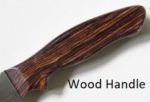
Wood is a popular material for making knife handles. It is easy to shape the wood in ergonomic designs that make the knives comfortable to hold. Consumers enjoy the attractiveness of wood handles. This is not the case with health inspectors. They cite concerns over safety because of the ability of wood to trap bacteria and pass it on through cross contamination.
Stainless Steel Handles
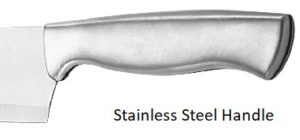
Stainless steel are durable knife handles that do not require special maintenance. They clean easily and have gained favor of health inspectors. This handle type is heavier and it can help to improve the balance of a knife. They are tough and hold up well. The only real downside is that when they are wet, they are slippery and can be harder to hold onto unless a special grip design is implemented.
Plastic Handles
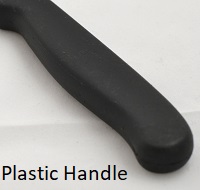
Plastic Handles are the most common type that is found on knives. They have a lot of advantages over the other kinds. Plastic is usually very easy to clean. The newer materials used in the plastic make them highly durable. Most plastic knife handles are molded with a texture that makes them easier to grip and hold on to. The only downside is that some of the cheaper plastic handles are subject to cracking and chipping.
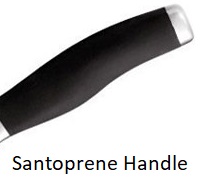
Santoprene Handles
Santoprene Handles are made from a unique formulation. Polypropylene and synthetic rubber are the main ingredients. These compounds give it slip resistance so the knife is easier to hold on to. Santoprene is a highly durable material. These handles are available in higher end knives.

Types of Knife Edges
Straight Edge
A straight edge knife is also known as a flat ground. It is one of the most common types of knife blade. Straight edge knives are ground in a straight line. This adds a beneficial taper. This characteristic form a razor sharp edge. Straight edge are a popular choice because of their extreme sharpness.
Granton Edge
The Granton Edge is a different type of edge that features hollowed out portions on the blade. The hollows are machined into both sides. This makes the knife more efficient for slicing meat. These special grooves create a tiny space for air that remains in between the blade and the item that is being cut. It helps the knife to slide more easily through dense foods.
Serrated Edge
Knives with a serrated edge have the appearance of a scallop or wave on the surface of the edge. Serrating creates a tooth-like feature on the blade edge. This helps improve the cutting process. it is favored when there is a thick skin that needs to be penetrated. Serrated blades lessen the chance of the food tearing when it is being sliced.
Hollow Ground Edge
Hollow Ground edges are made using a grinding technique that begins beneath the blade’s midpoint. The method forms concave sides that join to form a paper thin cutting edge. The hollow ground edge is popular for sushi and other knives that are intended for slicing paper thin cuts in fruits and other types of foods. This edge type is excellent for skinning, peeling, making sushi or making thin garnishes. Thee thinness of the knife blade makes it more brittle so extra care is needed to protect it from damage.

Different Types of Knives for Different Jobs
Meat Carving Knife
What is a mean carving knife? A meat carving knife is also referred to as simply a carving knife. There are several different kinds, but they share the same purpose. A carving knife is for use in carving meats. This blade is thinner than knife the chef’s knife blade. This is for slicing thin cuts of meat. They are more efficient than the rounded blades.
Boning Knife
What is a boning knife? A boning knife is a type of meat cutting knife. They come in flexible blades and semi flexible. the average length of the blade ranges between three and eight inches. They are used to take the meat off of the bone. Professional butchers rely on them when boning roasts and other cuts of meats. The blades are made to bend so the user can keep them close to the bone to get more meat off with each cut.
Bread Knife
What is a bread knife? Bread knives are intended for slicing bread. They vary in blade size from seven to ten inches. A good bread knife will have a handle design that is offset so the user won’t hit their knuckles on the cutting board. The edge may either be slightly curved or straight. They all have a serrated edge to pierce hard crusts without damaging the softer food item beneath the crust.
Butcher Knife
What is a butcher knife? A butcher knife is easy to recognize by its appearance. They are wide and heavy. The blades are slightly curved to make them effective for trimming, sectioning and cutting big pieces of meat. They are an essential in any butcher shop. Butcher knives are also common in most household kitchens for meat preparation.
Breaking Knife
What is a breaking knife? A breaking knife is like a small butcher knife. Its main use is to cut big pieces of meat into smaller portions. The length of the blade is generally ten inches. They are curved to give the user leverage through the curved design of the blade. They are used for cutting or breaking through tough skin, smaller bones and cartilage. They are also used to trim fat off of meat.
Chef’s Knife
What is a chef’s knife? The chef’s knife is also known as a cook’s knife. It is a knife that is used in most commercial kitchens. The blades are wide and they feature symmetrical sides that come to a tapered point. The blade lengths can range from 6 to 14 inches. They are used for a variety of cutting, slicing, mincing and chopping tasks.
Cimeter
What is a cimeter knife? The cimeter knife is also commonly called a scimitar. It is similar to a butcher knife. The main difference is that the blade is fashioned with an upwards curve. This makes it the ideal knife for cutting steaks and trimming them. It’s a knife you are most likely to see in a butcher’s shop.
Cleaver
What is a cleaver knife? A cleaver is a knife that has distinct features. The blade is wide and long. The cleaver allows the user to exert a great deal of force for chopping through thick cuts of meat and even bone. This is another knife you are likely to see in a butcher’s shop, but it’s also common to see them in household kitchens.
Deba Knife
What is a Deba knife? The Deba knife is similar to a cleaver. It is used for medium duty chopping and cutting. It is usually used for cutting meat and fish. It is also preferred for cutting vegetables that are hard. Its design allows it to more easily break through hard food items.
Flank and Shoulder Knife
What is a flank and shoulder knife? A flank and shoulder knife is a specialty type. You see them most often in a butcher’s shop. They are in the boning knife category. Flank and shoulder knives are used for making precise meat cuts because of the stiff blade. They are also useful in jointing, boning and trimming.
Gyuto Knife
What is a gyuto knife? A Gyuto knife is much like a chef’s knife. It is a multi-purpose cutting tool that performs many of the same functions. There are a few differences that distinguish the Gyuto knife It has a thinner blade, it is lighter and the edge is much flatter than a chef’s knife. It is valued for its superior push cutting capabilities.

Nakiri Knife
What is a nakiri knife? A Nakiri knife is designed specifically for cutting vegetables. It has an extremely thin blade. This makes it the perfect knife for slicing paper thin vegetable garnishes. The edges are razor sharp and tapered. It is recommended for use with seedless vegetables.
Oyster Knife
What is an oyster knife? An oyster knife is used for shucking oysters from their shells. Although they come in a variety of sizes, all share a few common characteristics. They have a very thin blade. This makes it easy to slide the blade inside the oyster shell. They are also designed for loosening the oyster from its shell for easy removal.
Paring Knife
What is a paring knife? Paring knives are among the most versatile tools found in a commercial kitchen. They are also found in nearly every household kitchen. They can be used for a variety of tasks. They feature a shorter blade length and can be used for peeling, slicing, dicing or cubing. They are second in popularity only to the chef’s knbowife.
Petty Knife
What is a petty knife? The petty knife is similar to a utility knife. The blade design is very thin. It features a light construction for precision cutting and slicing. It is also useful for dicing smaller food items. Petty knives are generally used for cutting fruits or vegetables with a soft texture.
Santoku Knife
What is a santoku knife? The Santoku knife is a popular all-purpose knife. It does everything that a chef’s knife will do. It is used to slice, dice and mince. The knife originated in Japan. It is becoming the knife of choice, being preferred by some to the classic chef’s knife.
Sashimi Knife
What is a sashimi knife? The Sashimi knife is designed for slicing. It is most often used for every day slicing tasks. The thin blade allows it to move through fruits, vegetables and meats with ease. Some use it for cutting smaller pieces of fish from larger ones. The Sashsimi is a Japanese style knife.
Slicing Knife
What is a slicing knife? A slicing knife is recognized by its long blade that is straight. It is made for slicing sushi and meats that have been cooked. Many slicers are engineered with a blunt tip and a Granton edge. Slicers come in a variety of lengths and widths. They are a specialty knife that are used specifically for the task of slicing meats.
Usuba Knife
What is a usuba knife? The Usuba knife is made for slicing ultra thin vegetables. It is a favorite for making garnishes. The knife features a very thin blade. It is a Japanese style specialty knife that is favored for slicing vegetables that do not contain hard seeds. It is a popular knife in commercial and household kitchens.
Utility Knife
What is a utility knife? Utility knives often have a scalloped edge, and can be considered a cross between a paring knife and a slicing knife. A sharp utility knife is very efficient for slicing softer fruits and vegetables, such as tomatoes or squash. Utility knives are also great for cutting large melon rings, cutting heads of lettuce into wedges, preparing cabbage for shredding, and halving citrus fruits.
Pocket knife
What is a pocket knife? Pocket knives are compact in size and designed to be carried in the pocket. Some models have a folding blade that can be locked into place for safety from accidental opening. They are lightweight and portable. These knives come in a variety of sizes and styles. Some pocket knives feature multiple blade sizes and styles in one product.
Bowie Knife
What is a bowie knife? The Bowie knife was created in the 19th century by James Black. It is designed for use as a hunting knife. It has a curved top and the blade has a clip bevel. It is commonly used for skinning and butchering wild game. It can be sharpened to a razor’s edge. It is a larger knife that is popular among hunters.
Fillet knife
What is a fillet knife? The fillet knife is similar in appearance to a boning knife. The difference is that it has a thinner blade. The boning knife allows for the user to achieve better endurance of force for challenging cutting jobs. The fillet knife is used to cut thin slices of fish and has a blade that is thinner. It is also made to be longer and more flexible.
Neck knife
What is a neck knife? The neck knife is a specialty knife that many consider as a novelty. It is a small fixed blade knife. A cord is threaded through the butt. This makes it possible to wear suspended from around the neck. Mountain men wore these knives with the hang handle up, but it can be worn either way.
Electric Knife
What is an electric knife? The electric knife is designed to do all the cutting work for you. It takes the place of a carving knife. This device is powered by electricity which causes the blades to move side to side in a slicing motion. It is usually used for carving. Electric knives can also be used for slicing.
OTF Knife
What is an OTF knife? An OTF Knife is also called an out the front knife, a telescoping knife or a sliding knife. This is a type of pocket knife. It has a blade that is opened and closed through a space that is hollowed in an end of the handle. The unique design allows the blade to slide at a parallel angle with the handle when it is opened. This knife is suitable for use in survival situations. It is also used for self-defense.
Hatchets
What is a hatchet? A hatchet is very similar to an axe. It is a tool that is used for striking, cutting and splitting. It is an essential camping tool. Hatchets are made with a sharp blade for cutting or splitting. On the other side of the blade, there is a hammer head that makes it a two in one tool. A hatchet is also useful as a means of generating sparks through friction for starting fires.

Axes
There are several types of Axes. Theses are made of a steel blade that is attached to a wooden handle. They are often used to chop wood or to sliver off smaller pieces for campfire kindling. They are also used by firemen to cut through hard materials in rescue efforts. Axes are multi-functional tools that may be used for many things, including recreational target throwing as well as chopping through hard materials.
Shun Knife
What is a shun knife? Shun knives are sharpened to a sixteen degree cutting angle. The Shun produce knife is crafted of AUSS8A stainless steel. This makes it a little softer, but it’s tougher. The use of advanced steels makes the Shun a high performing knife. The Shun is a sharp knife type is available in a variety of knife styles including produce knives, meat cleavers and so on. This Japanese style kitchen knife is popular for its sharpness.
Sushi Knife
What is a sushi knife? A sushi knife is designed for thinly slicing and preparing sushi. It features a single beveled edge. It has a thin blade for precision slicing. Sushi knives are usually made from high carbon steel. This guarantees its capacity to take and hold a sharper edge.
Throwing Knife
What is a throwing knife? Throwing knives are made specifically for the popular sport. These knives feature a blade length between six and 12 inches. The blades are honed to have a sharp point, but they are dull on the sides. These knives are well balanced to improve accuracy of hitting the target. They are not intended for cutting or food preparation.
Boot knife
What is a boot knife? The boot knife is also referred to as a “gambler’s dagger.” The knife has a small fixed blade. It is a dagger style. It is intended to be carried on or inside a boot. This style of knife can also be worn under a pant leg or on a belt.
